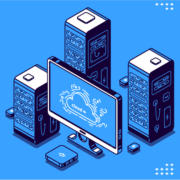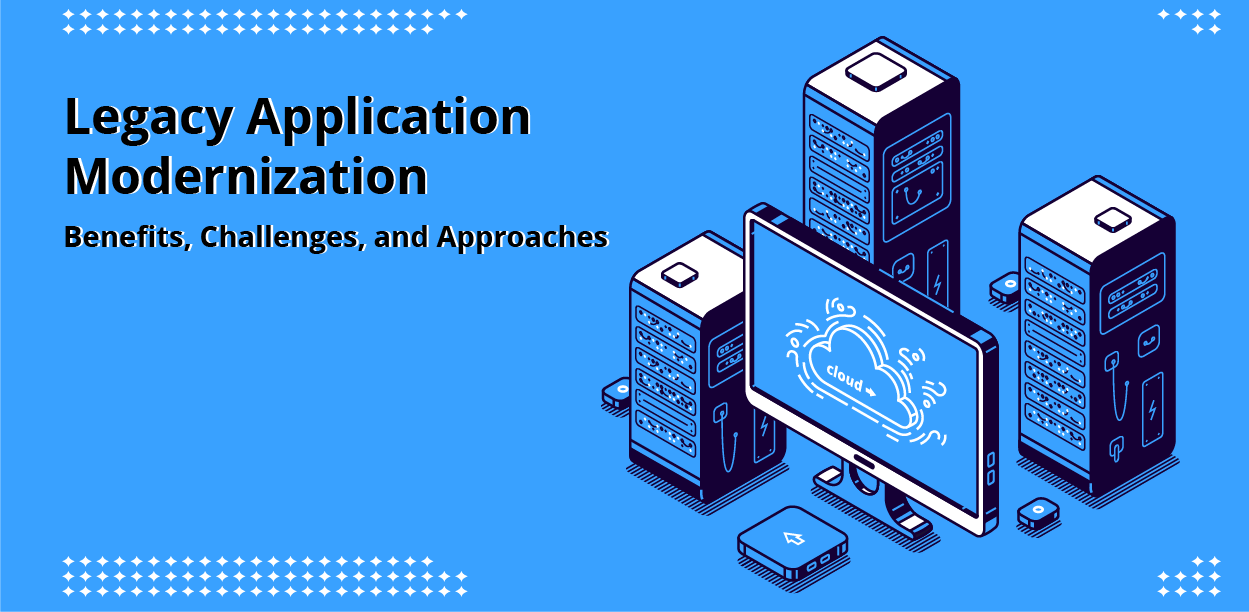Legacy Application Modernization: Benefits, Challenges and Approaches
Organizations typically invest considerably to procure or develop custom applications that support critical business operations. Unfortunately, when these applications go out of date, replacing them with newer applications is often not an option due to the amount of dependency these generate over time. However, these legacy applications can be updated and reconfigured to work seamlessly with modern platforms that are more efficient than legacy monolithic frameworks.
Migrating legacy applications to the cloud offers more comprehensive benefits such as platform flexibility, application scalability, robust security, and cross-platform compatibility. This article delves into the benefits of Legacy Application Modernization, related challenges and common approaches to migrating a legacy desktop application to the cloud.
Introduction to Legacy Application Modernization
Legacy applications require considerable investment to maintain competitiveness. More so, legacy applications follow a tightly coupled, monolithic architecture – that are susceptible to emerging security threats, are immutable and offer less scalability. As business dynamics keep changing, organizations relying on legacy applications must adopt consumer behaviour and embrace efficient models that enable holistic competence.
Legacy Application Modernization is a digital transformation strategy that repurposes existing software to make it compatible with modern devices and applications. Such applications can be rebuilt by rewriting the source code, augmenting the application or plugging the existing code and dependencies into a modern platform.
Key Reasons to Modernize Legacy Applications
With legacy app modernization, organizations can advance their systems to stay competitive, pivot with changing consumer needs, and adopt advanced technology for efficiency. The following are some of the key reasons organizations embrace app modernization:
Business Factors
- Maintaining ageing applications costs more, so modernizing legacy apps lead to reduced operational costs.
- Modernizing helps organizations gain a competitive advantage using systems with enhanced performance and agility.
- Modernized Legacy Applications boost efficiency and innovation since they are highly scalable, allowing for flexible deployment platforms and automation.
- Improved customer satisfaction as modernized applications meets modern performance and user experience standards.
Technical Factors
- Straightforward API integration with other software and third-party tools.
- Modernization keeps applications secure from ever-evolving security threats.
- Enhanced application performance with reduced security risks and reliable processes.
- Enables adoption of efficient operating models and frameworks such as DevOps.
Challenges of Legacy App Modernization
While embracing app modernization, organizations face several challenges. Some of these include:
- Resistance to change by employees/business stakeholders
- Inadequate requisite skills for migration and post-migration phases
- High initial costs
- Complex to replicate user-friendly systems
- Lack of clarity on the right cloud model to choose
- Inflexibility and incompatibility with external APIs and tools.
These challenges remain critical factors for an organization’s hesitation to app modernization. However, with thoughtful planning and coordinated execution, the benefits of achieving operational efficiency surpass the challenges in the longer run.
Approaches to Migrate a Legacy App to the Cloud
While the best strategy for transitioning to the cloud varies with the organization’s requirements, there are common approaches that can ensure a successful modernization.
-
Assess and Audit the Existing Tech Stack
Organizations must diligently assess the existing system’s performance and how effective it is for business processes. Doing so requires a comprehensive audit of related applications and infrastructure to establish whether the system is worth upgrading, and eventually helping to form the basis of the migration approach. Audit & Assessment also helps teams identify which software or infrastructure no longer adds value to the business, thereby helping to streamline migration efforts and costs.
Some important aspects to audit include:
- Architecture – An assessment of the application’s high-level architecture and components to identify bottlenecks that determine the most appropriate migration strategy.
- Code – A comprehensive audit of the source code to detect code errors, vulnerability, and compatibility with the new platform.
- UI/UX – Assessing user interfaces, supported operations and processes to ensure user experiences are seamlessly migrated over and remain unchanged.
-
Choosing the Right Migration Approach
One key consideration before planning a cloud migration is to decide the right approach to adopt. Existing workloads, expected load, and projected business requirements are often common factors in determining the right strategy. Depending on the business case, organizations may follow one of the two approaches:
Big Bang
This strategy typically refers to a lift-and-shift approach where the entire application is re-hosted to the cloud in a single milestone. As a quick option, this approach allows the legacy platform to be decommissioned, while the organization’s entire workloads are deployed to the cloud in a single move. The Big Bang approach offers a shorter implementation time and is considered perfect for organizations that utilize smaller, non-complex workloads.
Phased
The phased strategy refers to an approach in which the application workloads are shifted to the cloud in multiple, small milestones implemented over a period of time. This approach is considered suitable for large migration projects where it takes time to train the staff and for organizations that consist of multiple business units. Besides this, a phased approach offers additional benefits such as easier change management and a lower risk of failed migration.
More details on various cloud transformation strategies, including Rehosting, Replatforming, and Refactoring can be found here.
-
Forming the Right Team
As operating an application on a cloud-native ecosystem requires niche skills that are mostly different from an on-prem setup, organizations must plan to onboard the right team of experts who ensure legacy-to-cloud transitions are seamless. This can be done by reskilling its existing staff, hiring new resources or outsourcing to an external party to manage the transition as well as the BAU phase. Such experts are responsible for identifying components of the workload that require to be migrated and the challenges they may encounter.
A commonly known strategy as part of the migration is to invoke the Agile model to ensure the transformation is comprehensive and highly collaborative. With the right Agile team structure, organizations can efficiently address emerging customer expectations and achieve operational excellence.
An Agile team structure primarily includes the following roles:
- Product Manager
- Program Manager/Scrum Master
- Software Architect
- Software Developers (Frontend/Backend)
- DevOps Engineer
- User Experience Designer
- Quality Assurance Lead
-
Appropriate Financial Planning
Organizations must be wary of the associated costs of cloud migration. This typically involves an upfront lump sum for the shift and ongoing expenses during cloud usage. When budgeting for a cloud-based modernization, the migration program should identify financial projections of pre-migration, migration and post-migration phases. With appropriate budgeting, organizations unlock the comprehensive benefits of cloud migration as it helps teams allocate the right amounts of resources for configuration and deployment.
-
Choosing the Cloud Service
When migrating to the cloud, it is essential to pragmatically choose the right cloud service out of the following three models:
IaaS
Infrastructure-as-a-Service (IaaS) lets organizations acquire infrastructure resources such as storage, networks, processors and servers on-demand when required. Organizations only pay for the infrastructure they use for their workloads, which can be scaled to handle changes in resource demand.
Some popular IaaS offerings include Microsoft’s Azure, Amazon’s Web Services (AWS), and Google Cloud Platform (GCP).
PaaS
With Platform-as-a-Service, cloud providers manage the hardware and operating systems that allow organizations to focus on developing codes and automating deployment pipelines. This improves efficiency as it eliminates tedious capacity planning, resource procurement and software maintenance.
Some popular PaaS offerings include Windows Azure, AWS Elastic Beanstalk, and the Google App Engine.
SaaS
In Software-as-a-Service, the software vendors develop applications to be offered over the web. With SaaS models, organizations only need to plan, develop and maintain the application for end-use, rather than maintaining the underlying infrastructure or related platform.
Some popular SaaS applications include Microsoft Dropbox, Google Workspace, Salesforce, and SAP Concur.
Conclusion
As cloud computing enables rapid acceleration in enterprise growth, there is an emerging trend of organizations embracing the cloud to modernize legacy applications. Continuing the ongoing trend, a recent Gartner survey projects that almost 70% of organizations using cloud services today plan to increase their cloud spending in the future.
Legacy applications are traditionally run on-premises, that rely on slow, monolithic frameworks. As a result, legacy applications cannot keep up with the agility and performance requirements of modern devices. As organizations transition to the cloud to enable digital transformation and modernize applications, they must be mindful of the challenges and the right approach while doing so. The right migration strategy, however, depends on the type of application, budget and business needs.
To know more on how Optimus can help you modernize your legacy applications, contact us here.




